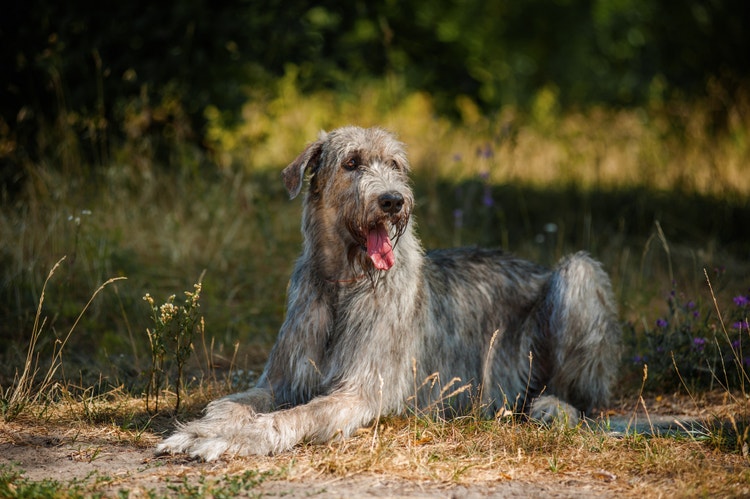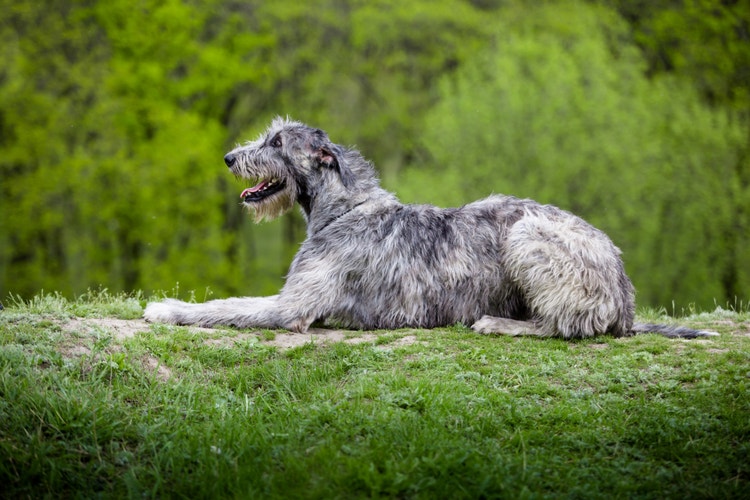
Irish Wolfhound


Where Are Irish Wolfhounds From?
The Wolfhound is a member of the sighthound group that includes Greyhounds, Afghans, and Scottish Deerhounds. They originated in Ireland, a result of crossing English dogs and Middle Eastern coursing hounds. The exact year of their creation is unknown, but they were written about as early as the 4th Century. They were such brilliant hunters of wolves and the now extinct Irish Elk that their prowess was said to exceed that of Mastiffs and Bulldogs. The breed nearly became extinct in the early to mid 19th century, when prey dwindled and they were no longer needed for the hunt. Fortunately, they experienced a resurgence in the late 1800’s when Captain George Graham of the British army concentrated on a careful breeding and standardization program to restore their numbers. Today, they are mostly companions, though some owners let their stretch their legs by competing in lure coursing.
Caring for an Irish Wolfhound
What Kind of Diet Does an Irish Wolfhound Need?
What Kind of Diet Does an Irish Wolfhound Need?
Wolfhounds are giant-breed dogs and prospective owners need to budget and keep in mind the large volume of food required over their lifetime. Their peak growth occurs around 18 months of age and, during this period, they need a large amount of calories and specific nutrients to keep up with their rapidly growing bodies. Make sure that they are fed a large-breed puppy diet. They are prone to gastric dilatation volvulus (GDV or bloat), so it may be helpful to feed smaller, more frequent meals and to avoid exercise around mealtime.
How Much Grooming Does an Irish Wolfhound Need?
How Much Grooming Does an Irish Wolfhound Need?
Grooming of an Irish Wolfhound is infrequent and relatively simple. Their wiry fur needs brushing weekly to keep it tangle free. They don’t shed much, but you will need to strip their undercoats twice yearly.
Are Irish Wolfhounds Healthy Dogs?
Are Irish Wolfhounds Healthy Dogs?
The Irish Wolfhound is giant-breed dog and, therefore, has associated health problems. Like most large dogs, their average lifespan is 6 to 8 years of age. Due to their size, they are predisposed to orthopedic issues including osteochondrosis dissecans (OCD), arthritis, hip dysplasia, and osteosarcoma. Cardiac issues are common in older Irish Wolfhounds, predominantly dilated cardiomyopathy. They should be screened for orthopedic, ocular, and cardiac disorders.
The Irish Wolfhound is predisposed to: gastric dilatation volvulus (GDV, bloat), hip dysplasia, cataracts, entropion, dilated cardiomyopathy (DCM), atrial fibrillation, von Willebrand’s disease, shoulder osteochondrosis (OCD), osteosarcoma, hypothyroidism, and Wobbler’s syndrome.
How Much Training Does an Irish Wolfhound Need?
How Much Training Does an Irish Wolfhound Need?
Wolfhounds are intelligent and do well with positive reinforcement training. Starting classes at an early age is necessary to keep your young Wolfhound out of trouble, since they can be destructive if bored. As they age, they develop a serenity that makes them perfect for therapy work.
How Much Exercise Does an Irish Wolfhound Need?
How Much Exercise Does an Irish Wolfhound Need?
Wolfhounds are running hounds that need space to stretch their long legs. They also have a strong prey drive, and care should be used when allowing them to run off leash, so they don’t chase other animals. As they age, they tend to develop lazier tendencies, but still need a daily walk or playtime to stay in shape. After the day is done, they love nothing more than to snuggle on the couch.
What Are the Physical Characteristics of an Irish Wolfhound?
Irish Wolfhound Facts
Other Breeds to Explore
References
- Irish Wolfhound Dog Breed Information and Personality Traits. Hill’s Pet Nutrition, Inc., 2020.
- American Kennel Club. The Complete Dog Book. Random House Digital, Inc., 2006.
- Morris, Desmond. Dogs: The Ultimate Dictionary of Over 1,000 Dog Breeds. Trafalgar Square, 2002.
- Wilcox, Bonnie and Chris Walkowicz. The Atlas of Dog Breeds of the World. T.F.H Publications, Inc., 1995.


